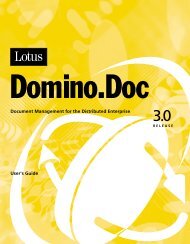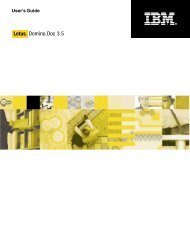Domino Document Manager - Lotus documentation
Domino Document Manager - Lotus documentation
Domino Document Manager - Lotus documentation
Create successful ePaper yourself
Turn your PDF publications into a flip-book with our unique Google optimized e-Paper software.
Performing replica server post-upgrade tasks for i5/OS<br />
After installing your replica server upgrade, perform the following steps to<br />
complete the replica upgrade:<br />
1. Restart all replica servers.<br />
2. Make sure that all of the replica server names and the <strong>Domino</strong>.Doc Site<br />
Administrators group exist in the ″Run unrestricted methods and operations″<br />
field in the Server document in the Directory (Address Book).<br />
3. Sign the templates and databases.<br />
For details, see the chapter on signing templates and databases.<br />
4. Run a replication cycle by entering from the master server:<br />
Repl replicaservername[/domain]<br />
Note: This process could take several minutes depending on the number of<br />
libraries and file cabinets you have installed.<br />
5. If you are using custom library and file cabinet templates that are not named<br />
domdoc.ntf and filecab.ntf, create a replica of each custom template on the<br />
replica servers.<br />
6. For each file cabinet that does not reside on the master server, refresh the<br />
design from the master file cabinet template, and then run the UpgradeAgent<br />
in the binder database and every document database.<br />
Tip: To identify all file cabinets not located on the master server, click Library<br />
Administration in the navigation pane, then click Replication, and select<br />
the Location Info view.<br />
7. Shut down the <strong>Domino</strong> replica servers and restart them.<br />
8. (Optional) If users will be accessing <strong>Document</strong> <strong>Manager</strong> libraries from the Web,<br />
create a database link to every library database on each replica server.<br />
For details, see ″Creating the database link″ in the chapter on setup procedure<br />
for all platforms.<br />
Removing <strong>Document</strong> <strong>Manager</strong> server software from i5/OS<br />
You can remove the <strong>Lotus</strong> <strong>Domino</strong> <strong>Document</strong> <strong>Manager</strong> software from a particular<br />
<strong>Domino</strong> server or remove it entirely from i5/OS.<br />
Removing the software from a server<br />
The i5/OS Remove <strong>Lotus</strong> <strong>Domino</strong> <strong>Document</strong> <strong>Manager</strong> (RMVDOMDOC) command<br />
is provided to remove the <strong>Document</strong> <strong>Manager</strong> software from a <strong>Domino</strong> for i5/OS<br />
server.<br />
1. Shut down the <strong>Domino</strong> server and the i5/OS subsystem in which the server<br />
was running. For more information, see Installing and Managing <strong>Domino</strong> for<br />
i5/OS.<br />
2. On any i5/OS command line, type:<br />
rmvdomdoc<br />
46 <strong>Document</strong> <strong>Manager</strong> Installation Guide<br />
3. Press F4 to display the command prompt.<br />
4. In the Server name field, type the name of the <strong>Domino</strong> server from which you<br />
want to remove the software.<br />
5. Press ENTER to run the command.<br />
The RMVDOMDOC command removes the <strong>Document</strong> <strong>Manager</strong> files that were<br />
installed by the ADDDOMDOC command; specifically, it removes:












